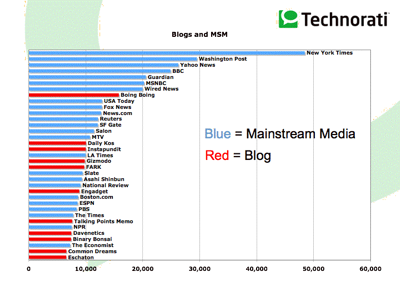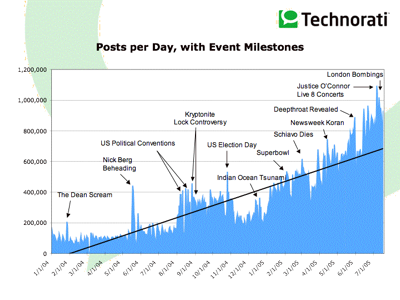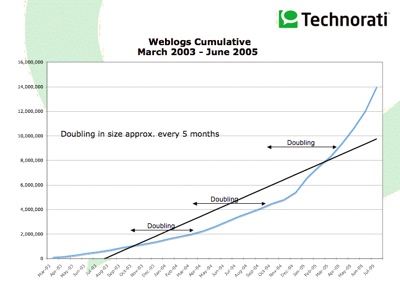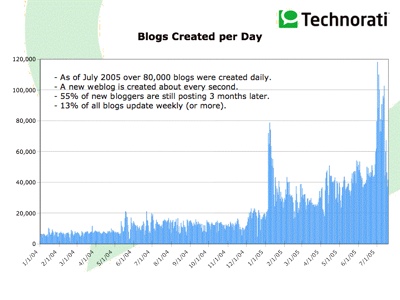Today's post is going to cover some new ground - Tags. This is new ground because Technorati started tracking and displaying blog post tags in January 2005.
A brief introduction to tags:
Tags are a simply categories or topics. Most blog tools make it easy to categorize your posts, and working with the microformats community, Technorati implemented a simple way to track and aggregate blog posts, photos, and links that are all categorized, or "tagged" with the same name. Unlike rigid taxonomy schemes that many people dislike using, the ease of tagging for personal organization with social incentives leads to a rich and discoverable system, often called a folksonomy. Intelligence is provided by real people from the bottom-up to aid social discovery. And with the right tag search and navigation, folksonomy may outperform more structured approches to classification, as Clay Shirky points out:
This is something the ‘well-designed metadata’ crowd has never understood — just because it’s better to have well-designed metadata along one axis does not mean that it is better along all axes, and the axis of cost, in particular, will trump any other advantage as it grows larger. And the cost of tagging large systems rigorously is crippling, so fantasies of using controlled metadata in environments like Flickr are really fantasies of users suddenly deciding to become disciples of information architecture.
For those of you interested in a deeper explanation, you can get more information on tags and Technorati's tagging implementation, including how it works and browse the top 250 tags in roman languages and across all languages as well.
Some Statistics:
First a look at the total number of blog posts with tags. The pickup rate has been nothing short of remarkable, over 25 Million blog posts with categories or tags, as shown in the chart below:
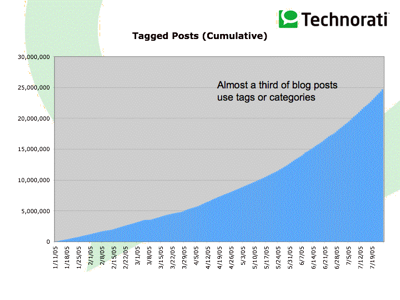
I can honestly say that no one at Technorati was expecting an adoption rate of that magnitude.
The chart below shows the number of tagged blog posts that we indexed each day from January through July of 2005:
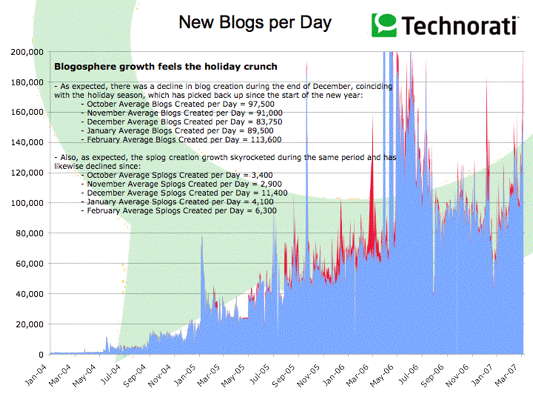
Almost a third of each day's blog postings use tags or categories - just over 300,000 posts each day at the end of July. What is also interesting is that people are also busily creating the "long tail" of tags on a daily basis as well. In other words, lots of people are creating new tags that are built for specific purposes, like for conferences or travelogues - some are using tags to help build communities around a topic. There are even spammers who tag (more on that tomorrow, grr). Some bloggers are using tags as a way to help organize information around an area or topic, as in the folksonomy example cited above, and event organizers are encouraging this by suggesting tags to them for use in their blog posts, photos, and on social bookmarking services like del.icio.us and furl. The chart below shows the number of brand new tags tracked each day. Note how it starts off with a big spike, as nearly 100,000 unique tags were tracked in the first week.
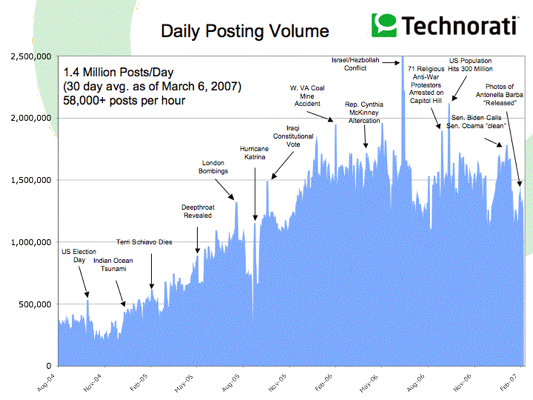
The numbers dipped somewhat as most common words were soon used as tags. However, growth in non-english languages, especially asian languages such as Chinese and Japanese has increased the average number of new tags seen each day to about 12,000 per day.
Of course, because the act of tagging is such a new thing, making predictions on where it will go in the future is anyone's guess. I believe that as long as the tagging system is set up to encourage accountability (e.g. link-based tags that are inside of a blog post) and discourage gaming, the folksonomy created will continue to provide useful in helping even non-bloggers to help view a more organized world.
Summary:
- Growth has been tremendous in the last 6 months: Technorati has tracked over 25 Million tagged posts from January to July of 2005
- About 300,000 posts with tags were tracked each day at the end of July
- About a third of all blog postings use tags or categories
- People are tagging more than blog posts: Popular services include tagging photos and links (social bookmarks)
- About 12,000 unique tags are discovered each day
- Tagging is growing in languages outside of English as well, including high adoption rates in asian languages like Chinese and Japanese
Oh, and one more thing: Thanks to our the computer visualization whizzes at the School of Art at Carnegie Mellon University, we came up with a video that shows the growth of tags in the blogosphere. You can see the most popular tags tracked each day as time goes from January (when things were still on a workbench) to late June 2005, when Technorati had tracked a total of about 20 Million tagged posts.
This is the video that was shown at the AlwaysOn conference last month, and we've had numerous requests to put it up on the internet. Thanks to a very generous donation of storage and bandwith from our friends at Ourmedia.org and The Internet Archive who have put the video up on their servers. You can watch the 320x160 version or the full size video.
Please note, the full-size video is 61 Megabytes, and the smaller video is 12.2MB, so it may take a while to load on low bandwidth connections. The video is licensed under Creative Commons Attribution-NonCommercial license so go ahead and remix, mash, and have fun with it, we had a blast making it.
Small Version (12.2MB)
Large Version (20MB)
UPDATE: If anyone wants to set up a bittorrent for the video, please go ahead and let me know, and I'll post the torrent info here!
Tomorrow: More on Spam...
Technorati Tags: AlwaysOn, blogosphere, blogs, delicious, flickr, internetarchive, ourmedia, posts, scaling, search, search engine, sotb, sotb2005, statistics, stats, tags, tagvideo, technorati, technoratitag, video, weblog, weblogs, wow

